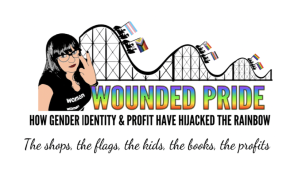 This was intended to be a short piece but has morphed into 8000+ words. It starts with an innocent trip to Bluewater shopping centre, where it muses on the packaging of Pride and looks at the evolution of the Pride flag. It explores how gender ideology affects children, checks out LGBTQIA+ young adult fiction in Waterstones, adds a handful of YA book recommendations from Jessie, pops into Primark & Hollister- where we discover where some of their Pride money goes- and ends up in M&S toilets.
This was intended to be a short piece but has morphed into 8000+ words. It starts with an innocent trip to Bluewater shopping centre, where it muses on the packaging of Pride and looks at the evolution of the Pride flag. It explores how gender ideology affects children, checks out LGBTQIA+ young adult fiction in Waterstones, adds a handful of YA book recommendations from Jessie, pops into Primark & Hollister- where we discover where some of their Pride money goes- and ends up in M&S toilets.
There are sub-headings. Wine, or coffee and Oreos, recommended.
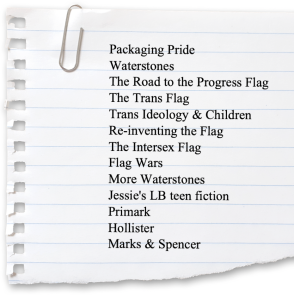
It was not intended to be a TERFy day out. I visited Bluewater with my mum and my friend Sophie, who, while they both know what a woman is, are not foot soldiers in the TERF wars. It was to be a nice normal afternoon, no stickers, no woowoo, no protests, just some lunch and a bit of shopping.
For those of you who aren’t in the know, Bluewater is a vast shopping centre down in the heart of Kent, a phoenix of capitalist endeavour rising from the dust of the surrounding chalk pit and designed very much along the lines of the Mall of America. Both buildings trap shoppers in endless loops of shops- escape one loop only to become ensconsed in another. Only the exits are tucked away inconspicuously. Bluewater is only the 5th biggest shopping centre in England, but has over 300 shops, 50 places to eat and drink and endless free car parking spaces. Depending on your perspective it is either the shopping experience of a lifetime or the seventh ring of hell. Bluewater likes to think it’s a bit upmarket. Fan of the generic globalised shopping experience? Bluewater throws in faux marble flooring with gold trim, quirky statues, wide, dramatic staircases, ponds, mini-golf and an electricity bill that would bankrupt a small country.
“Oh there’s a Primark,” said Sophie. “I thought it’d be too posh for that.”
Bluewater has a Pride page on its website, of course it does. It reads as if it was written by somebody with marshmallows for brains and goes something like this:
“LGBTQ+ community… be proud… simply being who you are… straight ally… being who you truly are… celebrate and support… iconic symbol… LGBTQ+ community… rainbow flag… pride style… wearing the rainbow… show your support… show your pride… be an ally or simply be proud… rainbow inspired… in honour of Pride month… Stonewall Riots… clothes that commemorate the occasion… feature a rainbow… blah blah blah”
“Let’s go shopping! Phone, keys, Pride flag…”
Packaging Pride
In the last decade the corporate giant that is now Pride has morphed from a grass-roots protest demanding gay equality into a sugar-and-spunk-sticky caricature of itself, double-dipped in glitter and held together with bubblegum and platitudes.
We keep being told ‘Pride is a Protest’ but methinks the theybie doth protest too much. In 2020s England, it can be hard to establish exactly what it is that Pride is protesting about. While LGB people now have equal rights in law in England, and much more representation in film and advertising, there’s still a lot of casual homophobia. Many parents find it hard to accept gay kids, which is evident in the fashion for transitioning sensitive little boys and rough-and-tumble little girls. Some people never dare tell their parents they are LGB, which is incredibly sad. Some people find it hard to tell themselves.
Homosexual activity is still illegal ‘to some extent’ in 71 countries and punishable by death in seven. This may be hard to grasp for 21st century kids in London, which is perhaps why we don’t see many placards concerned with such stuff on Pride marches.
But Pride doesn’t seem to be about fancying people of your own sex anymore. Some might suggest that a draggle of prancing drag queens in skirts showing their ‘panties’, sporting glitter, wigs and fake boobs is not going to help educate a reticent or homophobic parent into accepting their gay kid as being… well… normal. Realistically, it’s far more likely to have the opposite effect. And there we have it- being accepted as ‘just like everybody else’ is no longer an objective of Pride.
Some might suggest that trying to change sex with artificial hormones and surgery is perhaps not the most viable route to finding your authentic self, but those people would be evil bigots who hate you and want you to die. The protest part of Pride now focus on the validation of gender identity and how to aquire it.
This new objective seems to be going pretty well.
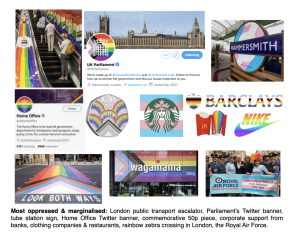
In the last couple of years, almost all UK government departments have flown the ‘progress’ Pride flag, or the trans flag, either outside buildings or on their social media accounts. Banks, multinationals, schools, universities, the army, navy and police force fly the flags. It’s on our zebra crossings and it appears on commemorative legal tender. Gender identity ideologues seem to have the establishment pretty well under control. It was even revealed in the Telegraph this week that OFSTED have been marking schools down for not teaching the kids enough gender identity theory. At least four schools were marked down with the following comments:
“pupils do not learn about gender identity or gender diversity”… ‘lack of teaching gender identity… “lack of gender reassignment teaching”. One school in the North of England was told it needed to “ensure that pupils are supported to develop an awareness of, and respect for… gender identities”.
It seems as if it would be hard for the English establishment to prostrate itself any more profusely at the feet of the LGBTQIAA2+ ‘community’.
Could Pride be protesting a lack of T shirts? Definitely not…
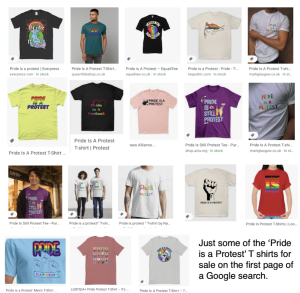 Google ‘Pride is a protest’ T shirt’ and you get thirteen million hits back in just a few seconds. The more realistic slogan ‘Pride is a corporate cash cow’ doesn’t seem to have caught on.
Google ‘Pride is a protest’ T shirt’ and you get thirteen million hits back in just a few seconds. The more realistic slogan ‘Pride is a corporate cash cow’ doesn’t seem to have caught on.
Pride these days: Progress flag? Tick. Rainbow umbrella? Tick. Rainbow facepaint? Tick? Fishnets? Tick.
Leather-clad puppy on a string? Optional.
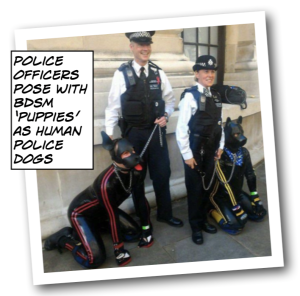
Any problems?
Don’t worry, ask a police officer.
They’ll be pleased to help.
Pride month: that time of year when the police dress up like idiots in a desperate attempt to placate a group of people who claim to hate them.
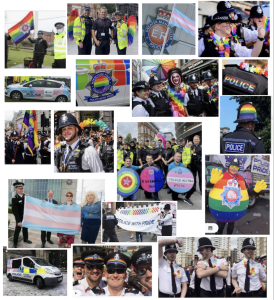
Who can blame the TRAs for that? They’re trying to look all hard and cool in their ‘black pampers’ outfits and along come the cops waving rainbows in their faces. It’s probably pretty much how the Arctic Monkeys felt when Gordon Brown said they were his favourite band.

Waterstones
Mr Waterstone started his first bookshop in London in 1982: just over a decade later he sold out to WH Smith and in 1998 HMV took over. According to Waterstones’ website, 66% of Brits regularly shop there.
Waterstones stores feel a little bit like upmarket libraries but with the obvious disadvantage of not being full of free reads. In recent years the company has come under fire for not promoting enough works by female authors, and deciding that certain feminist books were too controversial to display.
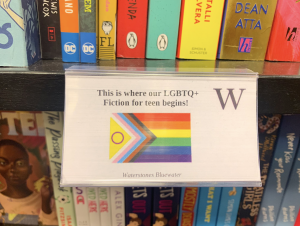 Their teen section is always stuffed with books about identity and anxiety, but it’s Pride month so they are
Their teen section is always stuffed with books about identity and anxiety, but it’s Pride month so they are pushing the trans agenda supporting gay kids even more than usual.
I wasn’t too surprised to see Waterstones had adopted this flag.
Flag? What is that monstrosity, I hear you ask?
Or maybe you know it already.
Either way, we’re going to have to take a little diversion here…
The road to the ‘Progress’ Flag

 The first Pride flag (top left) was designed by Gilbert Baker in 1978. He described it as symbolising ‘the rainbow of humanity‘. The eight stripes symbolised sex, life, healing, sunlight, nature, magic and art, serenity & spirit.
The first Pride flag (top left) was designed by Gilbert Baker in 1978. He described it as symbolising ‘the rainbow of humanity‘. The eight stripes symbolised sex, life, healing, sunlight, nature, magic and art, serenity & spirit.
‘Sex’ was removed after problems finding enough of the the right colour pink fabric. I’m not quite sure why the turquoise (symbolising ‘magic & art’) was removed but it was, leaving a more traditional rainbow, albeit with just six colours. The rainbow flag stuck around like that for quite a while.
The brown and black stripes for ‘LGBT people of colour‘ were added to the Philadelphia Pride flag in 2017 by the Philadelphia Office of LGBT Affairs in partnership with an advertising agency, after Gilbert died. This left a lot of stripes on the flag, especially once the colours of the trans flag, pink for girls, blue for boys and white for non binary people, had joined the party (see pics 3 & 4 in the flags above).
The Trans Flag
To be gay is to understand that sex is set at birth” – Brad Polumbo
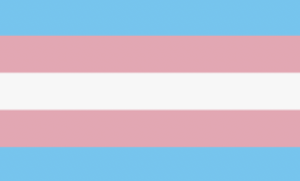 Obviously problems and conflicts will arise when you bring those who claim sex can be changed, or doesn’t matter, into a movement developed by and for those who are same-sex attracted. The blatent sexism behind the ‘pink for girls, blue for boys’ of the trans flag changes the meaning of the original Pride flag.
Obviously problems and conflicts will arise when you bring those who claim sex can be changed, or doesn’t matter, into a movement developed by and for those who are same-sex attracted. The blatent sexism behind the ‘pink for girls, blue for boys’ of the trans flag changes the meaning of the original Pride flag.
The trans flag was designed by dad of two and navy vet Monica Helms, aka Robert Hogg. Helms describes himself in his memoir as a ‘bigender’ person. This, he tells the reader, “allows my brain to float between multiple worlds… Sometimes I am a man and a woman at the same time, or I can change in a nanosecond, then change back just as fast.”
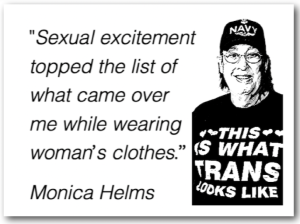
Of his penchant for cross dressing, he wrote, “It was the deepest, darkest secret in my entire life. I would tell someone that I’d murdered someone before I’d tell someone I cross-dressed.”
Helms, clearly a well-balanced sort of chap, refers to his childhood alter-ego as ‘the girl in the shadows’ and explains the design of the flag thus:
“The light blue is the traditional color for baby boys, and the pink is the traditional color for baby girls.”
This raises a flag of an entirely different colour for many people.
Read more about Helms in Genevieve Gluck’s piece on Redduxx.
Trans ideology and children
I and many others have written about the negative effects of gender identity theory on children, but we do need to briefly revisit it here. If you want to do a deeper dive you can start with the search bar on this blog, or check out Transgender Trend (UK) and 4thWaveNow (USA).
Trans ideology is a danger to children for several reasons. The cognitive dissonance is complex and predictably damaging. Many people claim there is little or no harm in social transition, but it offers a child an impossible dream that can only crash and burn with puberty – unless the child follows a medical pathway.
“Social transition isn’t reversible, because what we tell our children for years can’t be reversed.” writes an experienced clinical psychologist for Transgender Trend.
“When we disconnect them from their biological sex, we set up patterns of denial and secrets. We set them up to hate their bodies at puberty, to beg for blockers and binders, because for years we told them they could change sex, and they believed us. They are desperate to go back to the years when no one knew any different, but that time will never come again. Time is not reversible.”
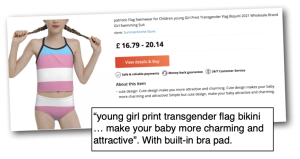 The concept of ‘trans kids’ didn’t even exist twenty years ago but is now at the very heart of our ostensibly liberal and diverse society.
The concept of ‘trans kids’ didn’t even exist twenty years ago but is now at the very heart of our ostensibly liberal and diverse society.
Let’s not lose sight of the fact that ‘trans’ is not a diagnosis, ‘gender dysphoria’ is a diagnosis. ‘Pink for girls and blue for boys’ is a symbol of all the stereotypes we had been working hard to break down before trans ideology came along and glued the wall back together again. And let’s remember that there are people out there who will sexualise children (above) and happily make them part of their fetish or agenda, whether it’s through hand crafting ‘packers’ so little girls can be ‘stealth’, or dressing little boys up like LOL dolls.

For older children, trans ideology offers a new start. The embarassment of childhood, fear of same-sex attraction, the complexities of autism, and/or a history of sexual abuse can all lead a young person to want to believe life would be better if they could change sex. And being trans offers you an instant tribe!
 The girl who thinks she makes a rubbish girl may be drawn to elective mastectomy, coolly remarketed as ‘top surgery’. Groups of girls may plan their transition together or start fundraisers to travel to see the sugeon of the moment. Boys may take hormones to grow breasts. They can buy them online. Parents who express dissent or concern are ‘transphobic’ and their kids are encouraged to ditch them. Every family thinks it won’t happen to them.
The girl who thinks she makes a rubbish girl may be drawn to elective mastectomy, coolly remarketed as ‘top surgery’. Groups of girls may plan their transition together or start fundraisers to travel to see the sugeon of the moment. Boys may take hormones to grow breasts. They can buy them online. Parents who express dissent or concern are ‘transphobic’ and their kids are encouraged to ditch them. Every family thinks it won’t happen to them.
One mum who found pills in her 16 year old son’s desk, after she noticed he was sprouting ‘breast buds’, said, “I don’t know how he paid for them but online hormones are so cheap. Like other kids doing this, he could have used his birthday money from Granny or pocket money.”
Once eighteen, either sex may opt for ‘bottom surgery’ which is frequently disastrous. Patients are left with phantom feeling, or no feeling: both sexes are left with urinary tract issues, incontinence, leaking and infections. Of course the resulting ‘genitals’ cannot function as naturally occurring genitals do. These surgeries, often still in experimental stages are comfortingly called ‘gender affirmation surgeries’ but many of the the stories coming from those who have undergone them are horrific.
We are now hearing a growing number of detransitoners tell their stories. One of the more recent to open up, Tulip, tells his story here. You can read or download the Transgender Trend ‘Detransition’ booklet, written by detransitioners, here.
Kids do need sex and relationship education. Kids should be taught about love, respect, consent, contraception & that it’s fine to love whoever you’re attracted to, whatever your sex. The rest of it they can work out for themselves, or from their peers, surely? Why on earth would kids need adults telling them about different sexual acts or positions?
Less and less energy is being put into telling kids its fine to grow up gay or bisexual, and more and more energy is being put into teaching kids how to decide what labels suit them best. Are you aporagender (a nonbinary gender identity describing the experience of having a specific gender that’s different from man, woman, or any combination of the two) or are you boring old cis? These concepts are based around the sexist stereotypes that denote boyish and girlish behaviours and inclinations.
Why so quick to apply labels in this quest to find your ‘authentic self’? A 12 year old is not an ‘aromanic asexual’, they are 12 FFS, plenty of people don’t develop any sort of sexual feelings until their late teens, and that’s just fine.
Being wild and quirky is ‘queer’! Masquerading as the opposite sex is authentic! Like ballet and football? Maybe you’re non binary! Everything we offer children concerning sex and relationships guidance is now being remoulded through the lens of gender identity.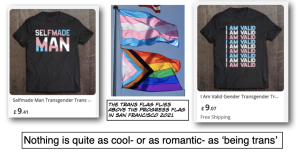
Young people are learning that their every thought is ‘valid’ and that they need to construct an identity, a lens through which they view the world. This identity doesn’t have to be based in reality, because while strong and powerful and authentic is also fragile as butterfly wings and ethereal as fairy spit. If it does not receive endless affirmation, its gossamer may fade or split or dissolve entirely. This new identity is a shallow reflection, worthless without the constant validation of others.
Anywhere that flies a flag sporting the trans colours is supporting the perpetuation of this myth.
Re-inventing the flag
So where were we? Ah yes. The latest flag. The rainbow flag had become rather cluttered stripe-wise, with no less than eleven bars running horizontally across it.
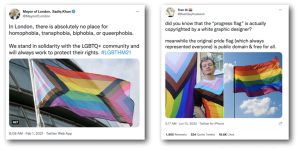
So, in an act of astonishing creative genius, arty enby Sam Quasar (just call me zie/zir) moved the five new colours sideways, effectively obscuring much of the original rainbow. I’m not quite sure why everybody was so impressed by this, but they were. The flag was accepted with enthusiasm and Quasar controversially copyrighted it.
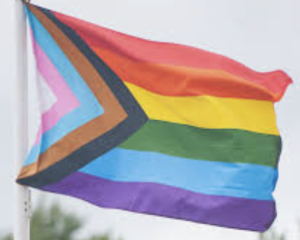 Not everybody loved the new flag. Many LGB people felt the added chevrons appeared to be pushing same-sex attracted people out of their own movement- but they were duly silenced with accusations of racism and transphobia.
Not everybody loved the new flag. Many LGB people felt the added chevrons appeared to be pushing same-sex attracted people out of their own movement- but they were duly silenced with accusations of racism and transphobia.
“The arrow points to the right to show forward movement,” said Quasar, blind or indifferent to the fact that further movement right would obscure even more of the rainbow.
In ‘Everything Wrong with the “Progress Pride Flag“ published in The Lesbian Post, the writer points out that ALL homosexual or bisexual people were already included under the rainbow flag.
“The only people left over,” she concludes, “the only people who could possibly be added to a symbol that represents every single same-sex attracted person in the world … are heterosexuals.”
The Intersex Flag
 In 2013 Morgan Carpenter of Intersex Human Rights Australia designed the intersex flag, a yellow background with the purple circle. Purple and yellow were chosen as a contrast to blue and pink, and the circle symbolises wholeness. You can see a video about the flag here. The issues facing intersex people are diverse and complex and often misunderstood and misrepresented.
In 2013 Morgan Carpenter of Intersex Human Rights Australia designed the intersex flag, a yellow background with the purple circle. Purple and yellow were chosen as a contrast to blue and pink, and the circle symbolises wholeness. You can see a video about the flag here. The issues facing intersex people are diverse and complex and often misunderstood and misrepresented.
The existence of intersex people does not prove that binary sex doesn’t really exist any more than a child being born with one leg disproves that human beings are a bipedal species. If the general public now believes that some people are born with two complete sets of genitals, or none at all, and that these people are as common as readheads – you can thanks the LGBTQI2+ lobby for that. Intersex conditions have nothing to do with transgenderism. This misinformation surrounding the subject is complex. Learn more from intersex advocate Claire Graham here and the Intersex Society of North America here.
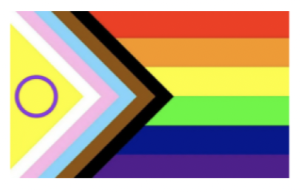 Last year Quasar’s flag was all the rage but the new, intersex inclusive flag (left), as seen in Waterstones teen book display, seems to have caught on this year. Designed (if that really is the word we have to use) by intersex activist Valentino Vecchietti (she/they) the flag was first popularised in 2021.
Last year Quasar’s flag was all the rage but the new, intersex inclusive flag (left), as seen in Waterstones teen book display, seems to have caught on this year. Designed (if that really is the word we have to use) by intersex activist Valentino Vecchietti (she/they) the flag was first popularised in 2021.
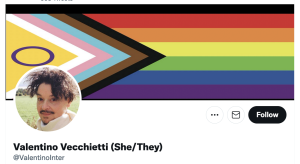
On the latest flag there is still a yellow background with a purple circle in the middle to represent intersex people. In keeping with Vecchietti’s vision, not only has a fifth, white, chevron been created by ousting the enbies to the right and hence further into the rainbow, but the intersex flag has been re-imagined as a yellow triangle.
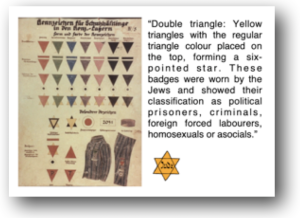 The yellow triangle, of course, was used by the Nazis as the basis for prisoner identification badges during the Holocaust and as such it already has a deep significance for Jewish people.
The yellow triangle, of course, was used by the Nazis as the basis for prisoner identification badges during the Holocaust and as such it already has a deep significance for Jewish people.
I wonder how this could have been overlooked by the designers of the ‘new’ progress flag or, in the light of ostensible respect for inclusion and identity, how they considered this act of appropriation acceptable.
Flag wars
What is going on here? I imagine Quasar may be feeling slightly miffed at having his flag usurped so quickly, especially after all that effort copyrighting it. Is there a secret ‘Pride flag war’ going on? And how many versions are there?
One version of the flag contains a red umbrella to symbolise ‘sex worker’ inclusion, and variated skin-tone stripes, but that doesn’t seem to have caught on. What next?
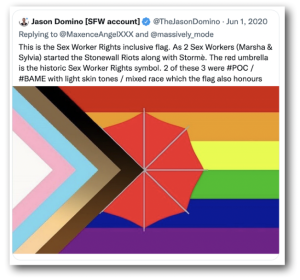 To be inclusive of all vulnerable minorities, surely the flag should also contain- at very least– a stripe for physically disabled people, a stripe for mental health and a stripe for elderly people? Oh, and one for left handed people. Yup, we die on average nine years earlier than you northpaws. That has to warrant a stripe!
To be inclusive of all vulnerable minorities, surely the flag should also contain- at very least– a stripe for physically disabled people, a stripe for mental health and a stripe for elderly people? Oh, and one for left handed people. Yup, we die on average nine years earlier than you northpaws. That has to warrant a stripe!
The overweight could perhaps have a double stripe.
Stop it, I’m overweight myself, I’m allowed to say that.
We have three stripes for trans people, those with gender dysphoria, so why not one for those with eating disorders? Those who self harm? Agoraphobics? If not, why not?
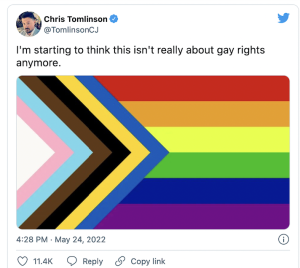 Bipolar people are much misunderstood and have a far higher suicide risk than trans-identified people. Why are they left off the flag?
Bipolar people are much misunderstood and have a far higher suicide risk than trans-identified people. Why are they left off the flag?
BIGOTS.
One Twitter user made a parody flag that included the colours of the Ukrainian flag. So many people thought it was real that Reuters ran a fact check on it.
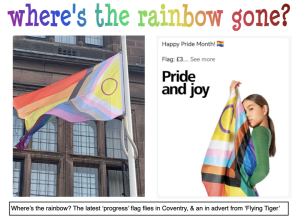
If you haven’t had a belly full of Pride flags yet, here Dr. Stacee Reicherzer, a man who identifies as a woman, will take you through a guided meditation on the colours. Enjoy.
Back to Waterstones
 Back to Waterstones where kids seeking out the LGB section are greeted with “This is where our LGBTQ+ Fiction for teen (sic) begins”.
Back to Waterstones where kids seeking out the LGB section are greeted with “This is where our LGBTQ+ Fiction for teen (sic) begins”.
And there’s the flag. And there are the books.
I flip through the books on the two ‘pride’ shelves and try to get an idea of the stories involved. I find three books that are lesbian romances. Afterlove, by Tanya Byrne, is about a lesbian love affair where one protagonist is dead and the other alive. I read a few pages and it takes my interest. Later I mention it to Jessie who remembers reading it years ago. She says it’s “pretty good”. I ask her to recommend some young adult LB fiction that’s ‘really good’ & she says ok.
There are certainly more trans and ‘queer’ books in Waterstones than lesbian books. The protagonist of one is a girl who ‘passes’ at school as a boy, until her right to play football is threatened by an evil sports teacher. There are books about how great and empowering it is for boys to dress up as and parody women. Books about special ‘non binary’ children and their nonbinary besites, who scoff at ‘cis’ people. Many of these books seems to have been written purely to tick boxes.
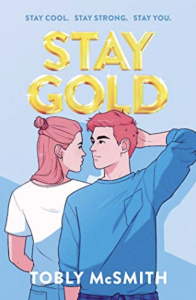 In ‘Stay Gold’, cheerleader Georgia discovers her new boyfriend ‘Pony’ is a girl. Georgia is briefly disturbed by the revelation and feels deceived. Scores of
In ‘Stay Gold’, cheerleader Georgia discovers her new boyfriend ‘Pony’ is a girl. Georgia is briefly disturbed by the revelation and feels deceived. Scores of virtuous handmaidens young girls in online fandoms rush to call the character ‘transphobic’ because of this. There are various subplots, one concerning Pony’s bigoted dad who won’t pay for her to have her breasts removed (spoiler, I’m told dad renounces his bigotry at the end).
Most of the books seem to be there to affirm specific ideas and to Educate The Reader. Even the target audience has cottoned on to this.
One young reviewer of ‘Stay Gold’ criticised sections of the book that “focus very heavily on explaining a myriad of concepts related to being trans, such as what binders are and why transmasculine people wear them, gender-corrective surgeries, and even how pronouns and names are not “preferred” but “correct… it completely took over Pony’s chance to show any personality beyond being trans and wanting to be perceived as his gender.”
Another reviewer wrote, “At times, this book felt stilted because portions would be ‘info dumps’ about living as a trans person, which felt more like they came from the author than naturally from the character. Further, depictions of violent sexual and physical assault, as well as inclusions of suicidal thoughts by the main character were included as a vehicle to educate.”
I didn’t read it all. I skimmed a couple of chapters and caught up on the plot when I got home. Like so many other of the books on the shelves, it’s an absolute clusterfuck of utterly confusing and beguiling nonsense. I picked it up pretty much at random, I don’t doubt there are others containing even more woowoo.
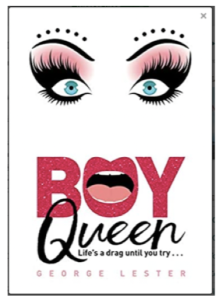 I aslso had a quick peep at ‘Boy Queen’ (recommended for age 12+) penned by drag queen George Lester aka That Girl. I was drawn to this one by its startling ‘blow up doll about to give a blow job’ cover.
I aslso had a quick peep at ‘Boy Queen’ (recommended for age 12+) penned by drag queen George Lester aka That Girl. I was drawn to this one by its startling ‘blow up doll about to give a blow job’ cover.
Despite the inference of the title, and the target audience, the ‘boy’ protagonist of the novel celebrates his eighteenth birthday in Chapter Two.
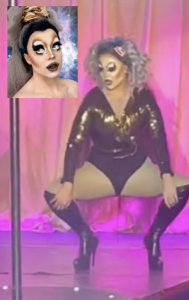
Lester, aka ‘That Girl’
Robin has a cool but in-the-closet boyfriend whose friends smoke weed. His friend Priya has perfect make up, an unsmudgeable ‘pop of highlighter’ and ‘perfectly drawn eyebrow(s)’. (We also learn that she’s overweight, so by the rules of woke it’s ok to objectifty her in that misogynistic ‘hey fatty you can be sexy too’ sort of way.) Next we meet Natalie who calls Robin ‘girl’ and ‘she’ and tells him she will be “ignoring advances from all genders” until she’s graduated. Their friend group also has Greg, in Robin’s words, a ‘token straight white boy. Every group needs one and he’s ours.’
According to Waterstones, it’s a tale ‘about embracing your true self’. Of course it is. The more cynical among us might think it was more of a tale of ticking the boxes.
The synopsis tells us that poor Robin is blighted with ‘a mother who won’t stop talking’ no less, so no wonder he’s drawn to an art form that involves mocking women where he can be his authentic self. When Robin’s mother isn’t talking she’s cooking homemade lasagne, or smiling with sparkling eyes as she cracks jokes about flirting with his teachers to get him higher grades. Robin’s mother is Perfect Parent and Pick Me Girl all rolled into one.
Boy Queen reads a bit like a well-structured GCSE English language creative writing essay, with the prescribed distribution of adjectives, adverbs and reported speech. It’s possible this is intentional, as discussion notes for schools are available here. I’d probably have given it an A for technique, possibly a high B. I read chapters 1-3. If GCSE English creative writing essays are your thing, you can read the first chapter here.
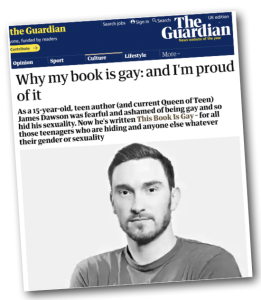 The two LGBTQ+ shelves also contained several books written by Juno/James Dawson, young adult fiction writer, once a role model for young gay men.
The two LGBTQ+ shelves also contained several books written by Juno/James Dawson, young adult fiction writer, once a role model for young gay men.
When James Dawson was a teenager the very last thing he would ever have believed is that he would one day be proud and happy to be gay.“ reported the Guardian in September 2014.
Dawson told the newspaper that as a fifteen year old he was was called a ‘poofter’ at school by bullies and “linked being gay to being wrong, naughty, faulty and broken. To him, gay people were dirty, they weren’t as good as straight people. He thought he was abnormal…”
In September 2014, James published the popular book ‘This Book is Gay’ declaring it to be ‘a non-fiction book in which I claim I could not be prouder to be a gay man’.
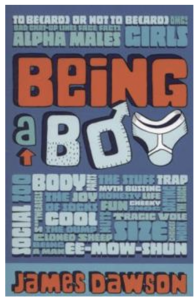 Fast forward one year: Dawson publicly declared he was a woman in October 2015, at the age of 34, and began taking hormones in 2016.
Fast forward one year: Dawson publicly declared he was a woman in October 2015, at the age of 34, and began taking hormones in 2016.
Nobody seems to have considered the implications of exposing young gay men to his work. Young men who, if they are effeminate, will have spent a lifetime being told they are second-rate men, or even ‘you’re a girl’, by the same bullies young James faced. Young men who will have seen a ‘proud gay man’ crumble and declare himself a facimilie of a woman instead.
When ‘This Book is Gay’ was first published, Dawson said “I hope that some of those young people who are in hiding, can see and hear me – a vaguely successful and very happy gay man being successful and happy.”
But that’s not what they’ve seen at all, is it? Since deciding he is a woman, Dawson is spouting the same homophobia that young gay men have always been subjected to.
“I think there are a lot of gay men out there who are gay men as a consolation prize becuase they couldn’t be women.”
Just what gay lads need to see during Pride. Nice one, Waterstones.
Here are Jessie’s promised recommendations for LB teens.

Jessie writes:
“Being a teenager, even in the early 2010s, there was a pretty minimal amount of lesbian books for me to read. I waded my way through John Green’s mediocre gay collaboration with Maureen Johnson and Lauren Myracle (Let It Snow, 2008) and David Levithan’s piles of boy-meets-boy teenfic for the background sapphic characters, but lesbian protagonists were few and far between. Now there’s a more varied selection, although I find myself having to look for these books specifically, as many of them aren’t put in the ‘LGBT’ sections of bookstores, but just placed in their genre section instead.
Here are some of my current and past favourite young adult sapphic novels.”
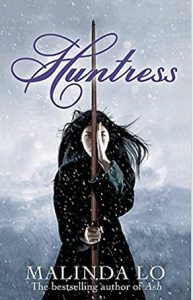 I read Huntress by Malinda Lo under the covers until 1am when I was about 13. The story follows Kaede and Taisin, sent on a mission to ‘fix nature’, which has been thrown out of balance. They make their way through a Chinese-influenced magical world, falling in love along the way. This is a prequel to her (also sapphic) rewrite of Cinderella, Ash.
I read Huntress by Malinda Lo under the covers until 1am when I was about 13. The story follows Kaede and Taisin, sent on a mission to ‘fix nature’, which has been thrown out of balance. They make their way through a Chinese-influenced magical world, falling in love along the way. This is a prequel to her (also sapphic) rewrite of Cinderella, Ash.
Suggested for 13+.
 The Crier’s War duology by Nina Varela is one of my all time favourite works, combining sci-fi and fantasy to create a lush world in which humans have been overpowered by ‘automae’: man-made sentient versions of people. It follows Lady Crier, an automa noblewoman, and a young servant girl, Ayla, whose biggest desire is to avenge her family by killing Crier in front of her father, Lord Hesod, who murdered her entire village when she was a child.
The Crier’s War duology by Nina Varela is one of my all time favourite works, combining sci-fi and fantasy to create a lush world in which humans have been overpowered by ‘automae’: man-made sentient versions of people. It follows Lady Crier, an automa noblewoman, and a young servant girl, Ayla, whose biggest desire is to avenge her family by killing Crier in front of her father, Lord Hesod, who murdered her entire village when she was a child.
Suggested for 13+.
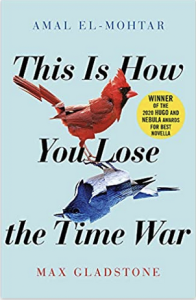 This is How You Lose the Time War by Amal El-Mohtar and Max Gladstone is a lyrical love story spanning centuries. A sci-fi novel following two agents on rival sides of a war, writing each other letters through time, and how their feelings towards one another develop.
This is How You Lose the Time War by Amal El-Mohtar and Max Gladstone is a lyrical love story spanning centuries. A sci-fi novel following two agents on rival sides of a war, writing each other letters through time, and how their feelings towards one another develop.
Suggested for 14+.
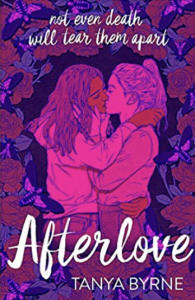 Afterlove by Tanya Byrne is about a girl called Ash, who dies but comes back as part of a group of teen girl grim reapers who roam the streets of Brighton helping other dead young girls cross over to the afterlife. Ash is determined to find a way to reconnect with her still-living girlfriend, Poppy, even though reapers are forbidden from communicating with people they knew before they died.
Afterlove by Tanya Byrne is about a girl called Ash, who dies but comes back as part of a group of teen girl grim reapers who roam the streets of Brighton helping other dead young girls cross over to the afterlife. Ash is determined to find a way to reconnect with her still-living girlfriend, Poppy, even though reapers are forbidden from communicating with people they knew before they died.
Suggested for 13+.
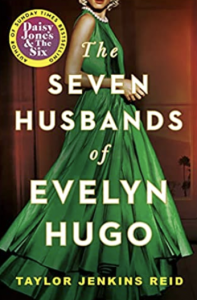 The Seven Husbands of Evelyn Hugo by Taylor Jenkins Reid. A young woman named Monica is given the chance to write the biography of 1950s Hollywood star Evelyn Hugo, who (surprise surprise) had seven husbands. But which one of them was her true love? Or was it someone else completely?
The Seven Husbands of Evelyn Hugo by Taylor Jenkins Reid. A young woman named Monica is given the chance to write the biography of 1950s Hollywood star Evelyn Hugo, who (surprise surprise) had seven husbands. But which one of them was her true love? Or was it someone else completely?
This book is not marketed as young adult fiction, but save for one fairly mild sex scene I don’t think there’s anything that would make it inappropriate, but because of this I would recommend it for ages 16+.
Primark
Ok. So, we’re at Bluewater shopping centre, remember? Next stop was Primark.
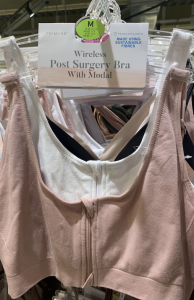 It was late last year when I spotted a trans flag in the bargain bucket of a London Primark store. Too woke even for its own customers.
It was late last year when I spotted a trans flag in the bargain bucket of a London Primark store. Too woke even for its own customers.
On this trip to Bluewater I noticed Primark now stock ‘post-surgery’ bras, either with or without cups for boobs (the cupless version is shown here).
Of course, this item is for all women post-surgery and if it increases the physical comfort of women post-mastectomy it is a good thing.
Earlier this year I spotted super-tight-fitting tops in Primark, clearly designed to function as a basic binder. H&M were selling a similar item before lockdown. Neither were marketed as ‘binders’; so far the high street giants have resisted conspicuous compliance with requests from angry teenage girls, via a handful of poorly circulated online petitions, to make chest binders more freely available.
The reason most repeatedly given in the text of these petitions is the unsubstantiated claim that trans-identified girls may kill themselves without access to such items.
Soon, one of these petitions will catch on and a retailer – I predict Primark, H&M or possibly M&S- will produce a range of cheap ‘n’ cheerful binders to get woke points and profit from the discomfort of dysphoric young women support young people in search of their authentic selves.
But having noticed the binder-style tops on an earlier visit, it got me thinking about Primark’s links to the whole LGBTQIA2+ shabangle, so when I got home I did some sleuthing.
Primark has not always had such stunning woke credentials.

In 2018 there was disappointment and anger expressed that profits from Primark’s ‘Pride’ range were being given to Stonewall rather than to the organisers of Pride events. Further egg appeared on Primark’s face when it was discovered that that year’s Pride merch was made in Turkey, Myanmar and China, countries known for having an abysmal record on gay rights.
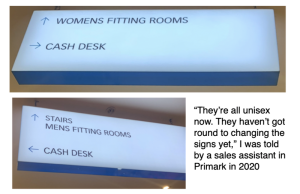 Primark had to pull its rainbow-striped socks up, quickly. And so it did.
Primark had to pull its rainbow-striped socks up, quickly. And so it did.
In 2019 it brought in ‘gender neutral’ changing rooms to some of its new stores, causing The Sun newspaper to call it a ‘gender offender‘ (groan) and in 2020 I was told by a young woman in a large London Primark store that despite the ‘Women’s’ and ‘Men’s’ signs over the changing rooms, they were “all unisex now”.
“Nothing says Pride like rainbow print… what better way to celebrate your most authentic self than in our newest collection of clothing and accessories?”
Primark advertising 2022.
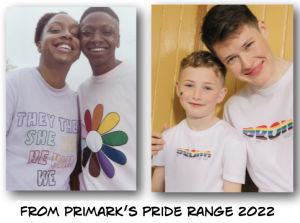 This year Primark’s emphasis is on pronouns and crisp white T shirts with rainbow slogans.
This year Primark’s emphasis is on pronouns and crisp white T shirts with rainbow slogans.
This year’s Primark Pride range features children in make up.
Since 2019, Primark has given nearly half a million quid to ILGA World, another organisation with an obsession with pushing queer theory to children.
ILGA runs the ‘Gender Identity, Gender Expression and Sex Characteristics Programme’ a ‘dedicated programme to advance the rights of trans people by strengthening work at the global and regional levels’. The first line of their constitution document states they recognise ‘ the fundamental pride that lesbians, gay men, bisexuals, trans people, and intersex people (LGBTI) have in their gender identity and expression, (my emphasis) sexual orientation, and sex characteristics”.
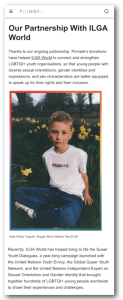 ILGA is a co-signator of the ‘Affirmation of Feminist Principles‘ (guess what, it has fuck all to do with feminism) which asserts that “all children should have access to gender transformative comprehensive sexuality education in schools that embraces the diversity of human identity.”
ILGA is a co-signator of the ‘Affirmation of Feminist Principles‘ (guess what, it has fuck all to do with feminism) which asserts that “all children should have access to gender transformative comprehensive sexuality education in schools that embraces the diversity of human identity.”
I’m not entirely sure what that means but I’m feeling the flutter of red flags.
If you were thinking that perhaps Primark was unaware of this connection, then I draw your attention to the image on the left, which is from Primark’s website and features a pre-pubescent child alongside a load of blurb about ‘queer youth’.
ILGA also holds that ‘sex work is work’ and that medical transition should be available free for anyone who wants it.
“Having a stronger global youth movement for the human rights of LGBTIQ people is
now more important than ever!” gushes ILGA.
Hollister
We enter a second circle of shops and are faced with a dramatic ‘Pride’ display in the window of Hollister, that well known friend of the underdog. Yes, this is the same Hollister that for many years employed its sales staff as ‘models’, allowing the company to hire based on looks and body type. So inclusive. Their Regents Street branch is so dimly lit that my friend who shops there turns on the torch on his phone so he can see the colours of the clothing properly. Dark the inside of its stores may be, but it seems Hollister has seen the metaphorical light, and is now especially concerned with Trans Rights and Black Trans Lives.
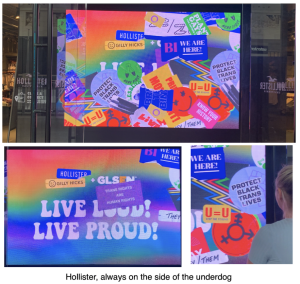
“Live Loud! Live Proud!” declares a huge neon display on a vast flickering TV screen, with startling originality. Presumably the customer is supposed to achieve this worthy objective while wearing one of the T shirts available to purchase within the store. I stop and stare at the screen. My mum and Sophie wander off without me but I am mesmerised.
It’s as if Pride just doesn’t actually have anything to do with fancying people of your own sex any more.
Slogans appear and disappear, badge & stickers style. ‘Protect Black Trans Lives’ and ‘Bi- we are here’ are the largest and appear most prominently. Others include ‘Trans Rights are Human Rights’ ‘BLM’, ‘Plant Gays- protect Mother Earth’, an ‘intersex’ symbol, a ‘trans’ symbol and a variety of pronouns – ‘U=U drop the stigma’, Zie/Zir, They/Them. Pride is a Movement. Briefly a flower appears with ‘lesbian lover’ written around the petals. On careful perusal, half a sticker appears to read ‘Break the Binary’. A green sticker reading ‘here first’ and sporting what might be feathers is a possible nod to ‘2 spirit’ people…
I didn’t enter Hollister, but I did have a look at their website when I got home. Items in their 2022 Pride range available include a ‘gender inclusive’ bikini, a snip at a mere £44.
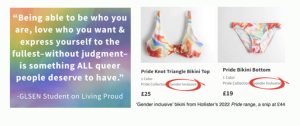
A GENDER INCLUSIVE BIKINI. Who needs an emotional support animal when they can get validation from their beachwear? I’m in. Or possibly not.
In 2021 Hollister donated $250,000 to GLSEN (pronounced ‘glisten’) an American organisation who work ‘to help create safe & affirming spaces for LGBTQ+ students in schools’. Via genderwoowoo, of course. This year they’re doing the same. Hollister has raised a cool £3,000,000 for GLSEN so far.
 “Being able to be who you are, love who you want and express yourself to the fullest- without judgement- is something ALL queer people deserve to have,”
“Being able to be who you are, love who you want and express yourself to the fullest- without judgement- is something ALL queer people deserve to have,”
GLSEN student.
“Gender expression is shown through clothing. Being nonbinary gives me the freedom to know that there is no way I’m ‘supposed’ to dress.”
Have the people who pen such stuff ever undergone any actual adversity, I wonder? The woowoo all sounds very worthy but what does it mean in the big, wide world where we don’t automatically deserve the right to ‘express ourselves to the fullest without judgment’?
We cannot stop people judging us. We cannot change how people perceive us. It is not a human right to be seen as we wish to be seen. When we tell people that it is reasonable to expect these things, we are setting them up for a lifetime of resentment and disappointment. Random strangers are not there to validate your feelings, because everything isn’t about you. Is that really such a harsh thing to say?
Pop on that gender inclusive bikini and get in the sea.
Marks & Spencers
Not just any old genderwoowoo…
Marks & Spencers likes to think that it excels in most areas, and the realm of genderwoowoo is no exception. In a bid to ditch its image of appealing to mostly middle class, middle-aged women, M&S has popped on its cashmere cardigan and leapt onto the gender identity bandwagon, possibly without reflecting on the fact that that demographic buys a fair bit of their stuff.
In November 2019 Jean Hatchet tweeted about a friend who took her fifteen year old daughter for her first bra fitting and was confronted with a man ‘getting his kicks’ trying on women’s underwear in the changing rooms.
“I can’t say anything or I’ll be a hater.” Hatchet’s friend told her.
In what the tabloid press referred to as a ‘gender row’, M&S responded to Hatchet, “All M&S fitting rooms have lockable cubicles designed to protect each customer’s privacy“. This was met with much disagreement from customers who reported their local stores had curtains or doors that didn’t go floor to ceiling.
Hatchet’s friend was right about one thing. For speaking out Hatchet was called a hater, a liar and accused of making the whole thing up. Which is weird because there are numerous recorded cases of men trying on underwear in M&S. I imagine some of them must have encountered teenage girls in passing. Or not passing, as is more likely to be the case.
“I had this in an M&S a couple months back.” commented one Twitter user. “Obvious male looking at bras and “joshing” loudly with the staff before going to try them in the female fitting rooms. I wanted to try some things but didn’t feel comfortable with him there, so hung around till he’d gone. Didn’t say anything…”
“In a Dublin M&S there is an obvious bloke who goes in for bra fittings (full beard & high heels) and the staff have to reschedule all the womens fittings for that day – and the staff are forced to do the bra fitting for him” observes another.
In 2019, M&S in Wales actually sent staff out, including a bra fitter, to solicit clients from a local trans support group under the guise of “making M&S more inclusive.”
“We discreetly went around the group explaining that we were there to help, that M&S is a friendly place which welcomes customers whoever they are, and that they shouldn’t be frightened to come into our stores,” Kelly said in an article on the M&S website, adding that she had to ‘reserve quite a lot of our products’.
On a different visit, “… some of the group modelled for me. They loved it and I was made to feel so welcome. After the meeting, many came for a bra fitting and one of the group specially brought their partner along for a new bra.”
On Reddit a 57 year old man who describes himself as ‘non-passing’ tells others, “I can vouch for M&S as being trans friendly as I went for a fitting earlier this year and was treated with the utmost respect and given some good advice.” Another replies that he was told he could have his fitting take place in either the male or the female changing area, depending on if he was male or female ‘presenting’ at the time.
Whatever angle I look at this from, I can’t help but see M&S’s female customers being used as unknowing supporting actors in men’s fantasy fetishes. I just really don’t think this is ok.
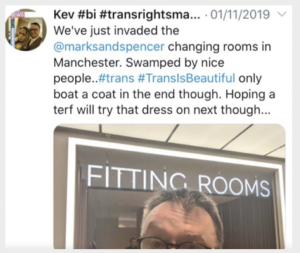 I wonder if female staff taking a job at M&S are warned in advance that the job may entail taking part in male sexual fantasies?
I wonder if female staff taking a job at M&S are warned in advance that the job may entail taking part in male sexual fantasies?
I would have hazzarded a guess at ‘no’ prior to hearing of Jane’s experience (as told to me by her friend Emma).
Jane worked for another large department store, Debenhams, where female staff were given special training in how to deal with men who used their free ‘personal shopper’ service. Debenhams Personal Shoppers “tell you about the latest trends and what clothes would suit you best… then you can sit back and relax whilst they bring you a selection of clothes.”
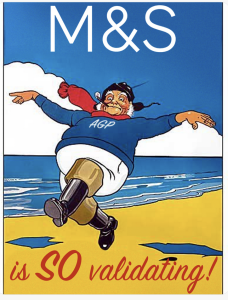
modification by @moleatthedoor
Some men would come in regularly to experience the validation of having ‘women’s’ items selected for them by compliant sales staff, who would then observe them in the selected garments and offer advice about style and fit.
Jane also said that on more than one occassion, discarded spunk-stained underwear was found abandoned by men who had taken it into the changing room.
“Not, like, all the time.” she added, hastily. “Just sometimes.”
Baroness Nicholson wrote to M&S in 2020, warning of the risks of voyeurs and predators, observing that M&S may have ‘misunderstood’ the Equality Act and suggesting ‘I believe you may wish to follow the Government’s line and resume single-sex spaces for the changing rooms in your stores.’
M&S remained unmoved, replying, “We recognise customers will self-identify and respect their right to choose the fitting rooms they feel comfortable in.”
In response to another enquiry an M&S social media rep replied:
‘As an inclusive retailer, in line with most other retailers, we allow customers the choice of fitting room in respect of how they identify themselves. Thanks, Matt’
Later in 2020 M&S were back in the news when a curvacious young woman was traumatised after a store failed to psychically glean her non-binary identity. After being asked not to use the men’s changing room, zie told an assistant, “I’m not female”. The assistant tactfully and immediately apologised but the damage was done. The woman, unable to discuss the incident through her tears, felt ‘sick’ and ‘accosted’ and went home and cried. M&S later issued a gushing apology, despite which the victim says she feels she will be unable to shop there again.
Back in October 2019, @GoodyActually asked M&S an important question, and one which, to the best of my knowledge, they have never addressed. “Your present policy only suits people that actively want mixed sex changing areas. What proportion of your customer base is that?”
Her question brings me to my experience in the loos.
Bluewater has a massive M&S (25 departments) which sports its own toilets. Sophie and my mum were looking at trousers so I popped over to the loos, where I was met with a sign that read:
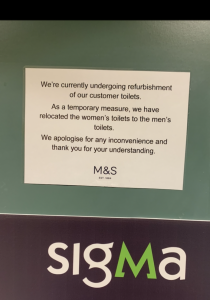 “We are currently undergoing refurbishment of our customer toilets. As a temporary measure we have relocated the women’s toilets to the men’s toilets. We apologise for any inconvenience and thank you for your understanding.
“We are currently undergoing refurbishment of our customer toilets. As a temporary measure we have relocated the women’s toilets to the men’s toilets. We apologise for any inconvenience and thank you for your understanding.
M&S
established 1884″
The message wasn’t entirely clear, sounding a bit as if they had literally relocated the women’s loos. Where had the men gone? Come ot think of it, I’d noticed a small group of men waiting outside the disabled toilet. But taking into account that M&S are clear that their facilities are divided by gender identity rather than by sex, I couldn’t help being sightly amused by the idea that a guy who wanted to use the women’s loo rather than the men’s because he wanted validation would actually end up having to use the men’s loo after all. Only by identifying as a woman could he come in and use the urinals! Which would presumably have become validating rather than triggering, because of the sign on the door? Or would it? As M&S are so incredibly sensitive towards the feelings of such fragile folx, perhaps the toilet door should have had a trigger warning on it? Have they learned nothing?
Musing on such things, I pushed through the door into the now-women’s loo. A woman who had gone in a few seconds before me looked around and said, “Oh, there are urinals! Oh dear, are we in the men’s?” I said I thought we were, but that it was temporariliy the Ladies.
The door opened again, a third woman entered, looked at the urinals, made a jokey gagging face and headed straight into a cubicle.
Another woman entered, looking from side to side nervously. “Am I in the right place? Is this the Ladies’ or the Gents’?”
“It’s the Ladies. Or at least I think it is, for now.””
She still seemed quite concerned. “Are you sure, are you sure? There won’t be any men in here?”
Only one of the cubicles was occupied and we’d just seen a woman enter it. The other woman assured her. “Definitely no men!” We laughed.
“Fair enough,” I said. “We don’t want to be sharing toilets with random men, do we?”
We agreed that we did not. She seemed reassured and ducked into a cubicle.
I did my wee, washed my hands and left. As I turned the corner I saw there were still three blokes waiting outside the disabled loo.
“Good to see you guys have still got somewhere to wee!” I joked as I walked past.
“Huh. None of that gender neutral non-binary bollocks here!” one said ruefully, with a joke-dramatic eye-roll at the queue.
“Well if the queue gets too long you guys can just say you’re women and go and use the Men’s again,” I replied, delighted at this unexpected and unsolicited flash of solidarity and yes, they laughed, because the whole exchange was fairly amusing.
Before I go on I should say that, yes, it’s crap that the disabled toilet was being used as the Men’s. I’m unsure what else M&S could have done under the circumstances, but it’s not ideal and this is probably a good place to give a shout out to the Changing Places campaign which aims to provide fully accessible toilets for people with disabilities. It may even have been that the men’s loos were intended to be mixed sex but, seeing the notice, the men had taken it on themselves to use the disabled loo instead. I don’t know if there was a second disabled toilet in M&S but Bluewater does offer a high dependency unit for the use of visitors and carers.
M&S came under fire again earlier this year when a young woman was told she couldn’t use the disabled toilets and was then hustled into the men’s loo, seemingly because she has short hair & a member of staff- who probably had concerns about single-sex loos- mistook her for a man. This type of situation would be far less likely to arise of course, if ACTUAL MEN could show the necessary self-respect and restraint to stay the hell out of the ladies loos.
As for urinals, let’s be realistic, they are not going to be used by women. Ever. It doesn’t matter what logo or word is on the door, MEN, LADIES or that weird symbol that looks like something out of one of Alistair Crowley’s notebooks- women do not use urinals. Oh ok, alright, there was one time a zillion years ago when I was really drunk in a club and absolutely DESPERATE for the loo and my friend somehow ended up helping me to wee in a urinal because she thought that was the best of a load of really bad options… but it’s all a bit of a blur TBH and not relevant because you know what I mean.
Marks and Spencers, this is the reality of your gender policies.
What happened here is relevant because these are pretty indicative responses. Remember, these three women were not expecting men to be in the toilet. There was a sign on the door saying it was currently allocated for women. Still they felt uncomfortable. This is how I interpreted what happened.
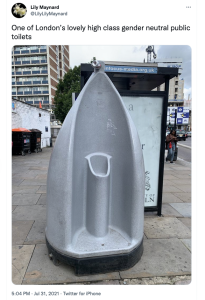 The first woman was a bit disconcerted and wanted to double check. She agreed when I said “We don’t want to be sharing toilets with random men, do we?” but didn’t seem intimidated by the idea. She’d prefer to have a single-sex space but it wasn’t a huge deal.
The first woman was a bit disconcerted and wanted to double check. She agreed when I said “We don’t want to be sharing toilets with random men, do we?” but didn’t seem intimidated by the idea. She’d prefer to have a single-sex space but it wasn’t a huge deal.
The second woman just thought urinals were gros & smelly -as they are, boys, FFS, they are disgusting things! Doesn’t your piss just splash back up all over you? Actually, don’t even answer that. Even though these ones were clean, we all know men piss all over the place. We city dwellers have seen it with our own eyes in those gros outdoor open sewers the city sticks up at the weekend. Ergo we may not want men in our toilets for that reason alone.
The third woman was very uncomfortable. Really didn’t like the idea that men might be in there, looked as if she felt trapped and not very safe even thinking about it, even after we had reassured her there were no men in the room. I should add that yes, there were cubicles and as far as I can remember they had floor to ceiling locked doors. She still felt uncomfortable. Her discomfort may have been for religious reasons but to be honest, the reason she felt uncomfortable shouldn’t matter. She still felt uncomfortable.
What about the guys?
Well, it’s not often men have to stand in a queue to use a public toilet, while women don’t have to wait, so that was probably a new experience for them. But they weren’t psychologically uncomfortable. They felt able to loudly and cheerfully make a joke to a complete stranger about the absurdity of non binary identities; that and their willingness to wait showed that they respected the importance of single sex toilets.
I would also hazzard a guess that had the women’s toilets been handed over to the men, the men would also have felt concerned and uncomfortable. Because not only do men just want to pee in peace, they recognise that women want privacy to go to the loo. A decent bloke doesn’t want to use the women’s toilets to validate his identity because he understands that women’s toilets are not about him, they are about giving women a single-sex space to wee, poo and bleed.
My conclusion? Female people would prefer toilets for females. Even the ones who don’t really care would prefer it. I wrote about this here back in 2018. To be honest, I’m gobsmacked it even needs to be said. And the same goes for changing rooms. OBVIOUSLY.
I mean seriously, M&S. It’s not rocket science.

Oh yeah, right. Happy Pride.

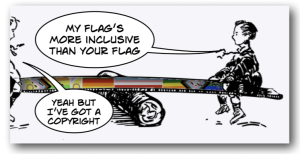
Hi Lily, I have been following you for a long time and you are amazing! I’m a gender critical aromantic asexual and I want to point out a serious error in your writing:
Aromantic means not romantically attracted to anyone, and asexual means not sexually attracted to anyone. So we have Heterosexual = attracted to opposite sex, Homosexual = attracted to same sex, Bisexual = attracted to both sexes, Asexual = attracted to neither sex. Similarly for aromantic, where the attraction is romantic but non-sexual.
Please replace the mention of aromantic asexual with something else truly gender-related in your sentence containing “aromantic asexual- all based around the sexist stereotypes that denote boyish and girlish behaviours and inclinations”. Aromantic asexual has nothing to do with gender whatsoever! It’s completely related to sexual attraction just like LGB — it’s essentially the opposite of bisexuality, in other words, “zerosexuality” or “nonsexuality”. There are so few of us gender critical asexuals (I know of only one other on Twitter) and it’s extremely disheartening to see you (whom we love and adore!) wrongly dismiss us as a sexist stereotype. You can replace it with “non-binary girlflux” or some other bullshit from here: https://gender.fandom.com/wiki/Genderflux
I myself am happy to chat with you about my experience as a gender critical aromantic asexual, either via email or on Twitter. I have some nasty experiences of abuse from other asexuals for my GC views, and I’d love to meet other GC asexuals like myself. Thank you for everything!
Hi Celine, thanks, i’ve fixed that now.I do understand the difference, thanks for pointing out the mistake.
Thank you for all your work on this. It was a sad, informative, entertaining read. Alarming, was that the info doesn’t surprise like it would once because anything is a possibility now.
Women are generally the victims (I mean real events not perceived victimhood) and now they are even more so- when men are on average 40% stronger than woman, how can they be not so?
I wish people wouldn’t go along with these narcissist bullies; they do so much harm and damage to people. My bright spot is people like you publicly clearing the way for reality and the clear-minded. Thank you.
I thought this was brilliant. Engaging, funny and informative. A thoroughly good read!